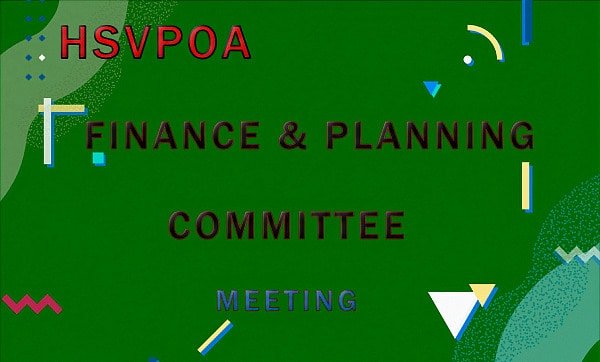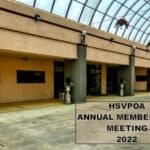Seven-year O & M Tables – planning, and budgeting; Kelly Hale reveals his thoughts on wants, needs and wise spending
You will not want to scroll on by this report as you will get a good look at our GM in action.
First, Controller, Coreena Fetterhoff, retiring from the HSVPOA on Thursday, March 17, explains a little bit about the O & M Process. In addition, General Manager, Kelly Hale, explains his position on fiscal responsibility and digs into the weeds to bring to light some of the things he has discovered since accepting the GM role. Let’s begin.
✤ ✤ ✤ ✤ ✤
The Hot Springs Village Finance and Planning Committee (F & P) met on February 28, 2022. I have been playing “catch-up” and apologize for the tardiness of this report. This is not a transcription.
Committee members are Chair, Larry Siener; Vice-chair, Tom Heau; Cathie Moeller; Jeffrey Lofgren; Karl Russ; Beckie DeYoung; and C. Ford Williams.
Staff Member is Coreena Fetterhoff.
Board Member is Gary Belair.
After approving the minutes from the most recent F & P meeting, the committee discussed the updates that Staff is making on the Seven-Year Operations and Maintenance tables (O & M). First Coreena Fetterhoff explained the O & M Process.
Fetterhoff Explains the O & M Table Process
Larry Siener, Chair of the F & P Committee asked Coreena Fetterhoff, Controller, and Board Treasurer, to give the committee an update on “where the O and M tables are going.
Fetterhoff said 2021 was the first year for the Seven-year O & M tables. Staff was originally directed to compile everything that they felt their department needed, “whether it was obtainable in the short term, or not,” explained Fetterhoff.
Staff is currently in the process of updating the Seven-year O & M and The F & P committee should receive this latest information by April 1, 2022.
After the data is reviewed by the F & P Committee, it then makes its way to the Board. The information in the O & M Tables is what is used to build the budgets.
Fetterhoff said she was, “a little bit late in getting that calendar over to Kelly [GM Kelly Hale]. I’ve made some modifications including the seven-year update and review process to that schedule and it’s in Kelly’s hands right now to go over. My assumption is once that gets fine-tuned and updated, then that is when they will start building the budget, based upon what is in that table.”
Fetterhoff said when you go to each department and what they classify as a need might be a little bit different than somebody else’s version of need. This was an all-inclusive list, which was supposed to be without “frills”.
Wants Versus Needs
Hale: “What is going on right now is I am taking the Seven-year O & M and going by function and taking a highlighter and playing 20 questions with the department managers. I am finding things that aren’t, in my mind, necessary within the next couple of years.”
Hale: “I will give you one specific example. There have been loaded in here about $375,000 for equipment in Public Works. A combination of about three or four different pieces of equipment to get into a new business venture for the POA that I told him is not happening because they are putting the cart before the horse.
Hale: “I’ve told all of the Departments and Coreena has heard this loud and clear, ‘you guys are like a bunch of kids with a Sears Catalog sitting in front of the fireplace, making out your list to Santa.”
Hale: “You guys have stuff on here that doesn’t even make any sense to me because this business venture that someone wanted to get into was to take big dumpsters like you see at the construction sites and start a brand new business with us going and [disposing of the trash/debris]…” We don’t have insurance. We don’t have the permits. All that is a whole new avenue. My message has been very clear to the POA. That is not our business model. I appreciate you trying to bring a revenue base here, but you’ve got no model to prove that you’re even going to make plug nickel one. And you’re going to take $375,000 as a start-up fee and you can’t show me a white paper that shows me where you are going to make any money – that you have historical data, anywhere, to back into this to show me how long it’s going to take me to pay off the $375,000 and when I [will] start making plug nickel one. But you want to put this onto the Members. No, we’re not doing that. It’s not in our business model.”
HSVPOA – Simple Business Model
Hale: “…Our business model is very simple. We get paid for building homes. That is it. I am not a developer. I am not a builder, but we make money off assessments, water, sewage, and sanitation. Anything else is an expense within the fenceline. Everything else we have costs us money. And we’ve got to be able to bring that up, that we’re treading water and just breaking even in a lot of cases and I am talking, golf, pool, tennis, pickleball – the usual things that we all moved here for. They are not going to make us any money. They are not high revenue generators. They are expenses is what they are.”
Hale: “It is a business reality. That is a fact. Our Members expect it as part of the assessments. But we don’t make any money off that. We will not be going into any new ventures to make money. We’re going to stick with what we’ve always done and that is to attract builders and developers to come in to buy the assets [lots] that we have and put rooftops in here and bring true revenue to the bottom line.”
Hale: “I am off-boarding a lot of these ‘get-rich-quick’ schemes. As I have been telling people, ‘we’re not going to do that.’ “
Hale: He said he has been spending the past three weeks (previous to February 28, 2022) digging in the woods. Literally. I have found equipment that has weeds growing up through it, that still looks good to me. We need to tow that stuff out. Get it out and find out what works and what doesn’t. I can put a new set of tires on it and make it run. Or, I can put a new set of plugs, or whatever. New hoses. I can put $10,000 into a unit versus spending $110,000 for a brand new one. To me, those are good business decisions and we need that equipment.”
Hale: “And then I get into a whole bunch of stuff that – $350,000 for [tree removal equipment]. I have a guy named Huey Applegate that did my property that works for the Village already. I can spend $350,000 with Huey Applegate. How many trees is he going to cut down before I use that $350,000? A lot. Probably most of the Village. But see, that is the mindset. Because the minute I buy a piece of equipment, I have to hire somebody to run it. I’ve got to hire somebody to maintain it. And I’ve got costs on maintaining that plus depreciation on everything we’re going to do. I am using an asset-like model because I am going through your Seven-year O & M and there are a lot of value-added things, but I don’t want to get outside the basic model of attracting builders to come in. We have 22,000 lots that we need to off-board, as far as what the POA owns, and get rid of those and get them in the hands of builders.
Keep it Simple
Hale: “But keep it simple, while we build up money. That’s it. We’re going to fix culverts. We’re going to fix the streets. I need to focus on the water and sewer treatment plants, which I’ve got about $3.5 million that we need to invest in there. But that is probably over a three-year period. That’s a big one that we really cannot take our eyes off of. That is real money we need to put back into the investment here. Beyond that, nothing. Pretty simple. We just paint, caulk, wash. I am not denying that we need some equipment, but I am not going to go into – ‘we haven’t bought anything for years and now we are just going to go hog wild’. No, we are not. We’re going to take our time. We are going to make sure we get it right and see what equipment we do need. One, I can’t get it anyway. Second, the inflationary environment that we are in right now is unbelievable. I am paying 30 – 40 percent higher than I would. I’ll hold onto my money and put it up for a reasonable rate of return and I’ll wait for this whole thing to come crashing and burning down like it did in ’09. Then as a Village, we will go on a buying spree. But until then, I don’t see us wasting our money. So, Larry [Siener], just a nutshell. That is what I am looking at. I am looking to spend our money wisely, but not get into these side projects that we are buying big equipment and doing all of these other things. I’ve already stumbled on close to a million dollars just in stuff that they can’t give me a good answer on and I just got going. But, that is the way I am seeing it.”
Hale: He said he looked at some common property today (February 28, 2022) because he is trying to develop a “long-term vision of how to put some amenities on the east end. Tennis courts, pickleball courts, basketball courts, nice little family area. We found some [property]. I don’t need to go buy more property from Cooper to get this. I think we can get it done with the existing property we already have. We are just going to repurpose something and clean it up; making it much nicer than it is now. But I believe we found what we want, to be able to put something in for the east end. But we’ll put our money out there – probably $350,000, I think, we can probably get something done. But I can make that up, just off these Seven-year O & M’s and make an investment in the neighborhood. That’s what I am looking at. That is how I am looking at it. I have a million questions, I am sure. But as I highlight them and make sure, we don’t need it, because there are some things we can use a vendor for to get us through the next few years and there are some things that we need to make long-term investments on.”
Siener said the GM was performing a “much-needed look through the data.”
Need to Spend Money Wisely – Road Scanning is Not a Deep Scan
Hale: “I’ll give you an example of something I am still questioning. And I am not an engineer by any means. But we had the survey crew that’s in here now that is doing all these [road and culvert] scannings. The impression that a lot of people tell me they had of this group, was they were going to come in and take radar and be able to see what is below the ground and actually see what is going on.”
Hale: “One hundred and twenty grand. It doesn’t do that at all. It just takes a laser of the top of the road. So basically what I can see out my windshield with cracks in the road. That is about what this is doing.”
Hale: He said that he didn’t know if the process is considered to be Lidar road scanning, but “I know in the demonstration they showed us, wasn’t what I thought we were getting. Because I thought we were going to be able to see the sewer lines, water lines, coming across the roads to be able to see if they are breaking down…This maybe goes down a 1/16 of an inch, if even that. It sees the cracks that are starting to develop. It does see a little bit more than the naked eye will show you, but not like what we were expecting. I don’t know if it is worth $115,000 to $120,000.”
Siener stated, “I was under the impression that their technology would be able to look three to six inches under the pavement so that you could see what was going on with the underlayment. And it sounds like maybe that’s not quite what we got.”
Hale: “I would bet if it does a 1/2 inch, would be about the max….Based upon the pictures and the demonstration and I asked them point-blank” if the equipment penetrated the surface.
Hale: The company replied, ‘No, we are just giving you stress’… They are going to do 560 miles of the Village. It is things like that, and someone asks the Public Works group about it – we used to go break into groups of three teams” and look at the roads that way. ‘This is just a little bit better way of doing it.'”
Hale: “Is it just easier? Or do we get something better for it? That is the question I can’t get anybody to answer.”
Hale: We will get data that interfaces with GIS to help create a long-term plan. “I guess my point is, I don’t know if we got our money’s worth. I don’t know if it is worth $115000 – $120,000.”
Cathie Moeller: “When it was presented, [the scanner] it was supposed to show the [road] sub-base. Which I assume like Larry [Siener] said, at least three or four inches. If it doesn’t do that, we cannot develop a Master Plan”
Gary Belair, POA Board Member, and F & P Committee Liason – “Everyone who talked about it in the last year and described it said we would be able to see the sub-base and see what needs to be replaced under the asphalt.”
Committee Members agreed and said this was their impression and they thought they could use the survey to develop a plan and link that plan to a culvert plan so we could actually have a good way forward on spending our money wisely and not ripping up roads for culverts and then going back in and having to repave them again and again.
Hale said he is hoping it will help us with that, but he didn’t get that impression from the vendor.
Hale: He said he is not saying this service is not going to be beneficial, but “I am pretty cheap, frugal – however, you want to put it. $115,000 to $120,000 is a lot of money to me. I don’t care how much we got. I would just like to see something that will give us more long-term [information]. The theory is there as far as being something that we can use as a road map for the next five, seven years. I get it. I really do. But, it is also going to change.” Kelly cited changing road conditions may make the information gleaned from the scan no longer accurate in a few years’ time.
Siener stated, “we need to be able to gather the data. We need to be able to construct a program [for many things]. “The culvert program is a 12 or 15, 18-year recovery program. We don’t have the financial resources to go at it much more aggressively than that.”
Hale: “No we don’t. And you have a scale of one to four. We’ve already started the one’s and two’s [priority rating]. That’s where I want to spend the money and the energy right now is the true infrastructure – which is where we are at. That’s what the Members want, as well.”
Hale Considers Ideas for Lake Dredging Cost Reductions
Hale: About two lakes a year are dredged. We have nine lakes. The cost to dredge the lakes is around $500,000 per lake. “That is a pretty good chunk of change. So here’s the question. I was out doing a site visit with them. Just hauling the mud out of there, the dirt, is close to $180,000 to $200,000 in just trucking fees.”
Hale: He challenged Jason Temple, Director of Public Services, to go find a vendor that already has the trucks, that wants the dirt and have him do the work for free. All we are doing is taking the dirt here in the Village and dumping it in a big hole. We are taking it over to the gravel pit and just dumping it…” This is black dirt that has some rock in it, “but premium dirt is premium dirt,”, especially on a mountain.
Hale: All we are doing is dropping the lake level and digging out dirt and dumping it. Hale said he thinks we could receive some payback for the dirt removed from the lakes. Hale said Jason Temple is checking with vendors and looking for opportunities.
Hale: The trucking cost associated with the removal of the dirt is $85 an hour. With three trucks, we are paying $255 an hour for three trucks to transport the dirt. This adds up quickly. We might be able to find a builder or someone that can use the dirt and would be willing to help us with the transportation. He wants to minimize this cost. “We have all these natural resources. But we treat them like trash. We pay somebody else to come to take our natural resources away. I am pretty sure that is not how that should work. We just have to go out and do some things a little differently.”
Details in F & P Tables are not Final/Contract Employees
Siener said it is probably not useful for the F & P Committee to dig into the details of the current F and P Tables because it is obvious from the conversation at the meeting that those details are going to change.
Fetterhoff said to expect a few improvements in the format of the O & M Tables. For example, the O & M Table formatting will be revised to coincide with the budget.
The committee discussed the advantages of using contract employees versus in-house workers.
LifeNet and Golf Carts
Hale: The contract with Lifenet is coming due this year and the golf cart contract expires next year. Hale said what we have now regarding the golf cart lease is “just a horrible deal. It is a six-year lease. There is a shelf life of about four and a half years. We have an average of 50 carts in the shop that we have to work on. “I believe there was something with the Club Car contract where we were promised a lot of things when we first signed with them. They promised they would have somebody here in the Village from Club Car to work on the golf carts. I don’t think that ever transpired.”
Fetterhoff – “I don’t know that it was promised. I have never seen that happen.”
Hale: It is a little bit cheaper to lease because of the maintenance agreement than it is to buy the golf carts.
Hale: We have to get in the habit of trading in (rotating)150 carts every year. We have 600 total golf carts. We also need to start considering the process of converting to lithium batteries. This will eventually require modification of the cart barns.
Equipment and Maintenance
Hale: Some large equipment will be shared between departments – Parks and Recreation, Golf, and Public Services.
Hale: “We seem to be all over the board with different things. We’re going to get a lot more focused and a lot more centralized on roads, culverts, bridges, paint, caulk, power washing. That’s it. That’s all we’re going to do for a while is just clean the place up. Fix what Cooper left us and save our money as we continue doing that.”
The committee discussed the problem with the buried fuel tanks, noting this will need to be dealt with in the future as there is a move to electric golf carts.
Requests Not Being Pursued
Hale: “Things that jump off the page at me, that I have no intention of even pursuing at this point in time:
- Additional outdoor basketball courts – doesn’t meet the needs of the eastside – $35,000
- $7,500 for arcade equipment for the DeSoto Recreation. ‘I am hoping to God they didn’t [mean] like pinball machines and things like that.’ Hale told them, “go down the street…it is just something else I have to manage.”
- Disc golf course
- Pickleball roof canopy – $225,000
- Pontoon Boat and pontoon replacement boat – we have about $85,000 for pontoons. Kelly asked, “How much money do we make on renting out pontoons every year? No one could answer that question for me but they want another $85,000 for buying more.”
The Committee agreed there should be no new amenities.
Hale: Someone approached him about building an equestrian facility for the Village. “I am not doing that, either. You can get in your car and go down Hwy 5 to Benton. There’s a guy on the left-hand side by the Dollar General. He will charge you $100 and you can go ride until you are blue in the face and then come back home. But I am not putting it in because then I have to manage it.”
Hale: We have people that want to donate things but then we are responsible for the maintenance. “We’re going to get out of that. Another $125,000 for pickleball repairs and then an RV Park restroom and showers. I’m not denying that might be good if I see some more revenue come in.”
Committee Member – “That is one of the areas where we actually make money so that one is not a bad idea.”
Hale: “$275,000 [for restroom and showers at the RV Park]. Can’t make this up.”
Hale: Some gentlemen approached him about putting in golf simulators at the DeSoto Club. Hale said, “Let me make sure I heard you right. We have an outdoor golf course and you want me to put indoor golf simulators at the golf course. Say that out loud to yourself now. And then when I asked them for their business model, ‘how much money am I going to make on this?’
Hale: The answer was, ‘We don’t know.’
Hale: ‘My utilities are $17,000 a month. I need you to pick up 80% of those if you want to put this in. Are you going to make at least $18,000 a month?’
Hale: The gentlemen said, ‘We have no idea.’
Revenue Plan/Entertainment
Siener said that he is sure that Hale is going to get to it, but we need a revenue plan. One of the ways of increasing revenue was by raising the golf fees for three consecutive years.
Siener questioned whether we make any revenue off the entertainment at the Woodlands. The facility costs a significant amount of money to manage and the revenue is significantly less than the costs of operating the facility. “I wouldn’t expect it to be a break-even proposition, but if we can do something for revenue growth over the next three, four, or five years to be able to get us a little closer to break even on that, that would save us money here that we can spend somewhere else.”
Hale: “If the POA puts on the concert, we make good revenue. If the [Village Concerts Association] VCA or any other group puts on a concert, we don’t even cover our expenses. I explained that to the VCA when they were telling me all the things they did for us. I said, “No, you don’t. We do a lot for your group. You really don’t. I don’t mean to be rude to you sir, but since you want to come up and explain this to me that way, I’ll tell you exactly the way it is. We make about $1,500 every time a charitable group does it over here. The only reason the POA goes along with that is that donations were brought together from the majority of them to build the Woodlands. So we give back. We put on 40 to 45 shows a year over here. The VCA only has five…They were upset with the fact that we had so many shows over there and wanted me to reduce the number of shows we do. I am not going to do that. The Members want to go to all these different shows”.
Hale: The VCA said, ‘yes, but they are taking away from us.’
Hale: ‘I said, do you know how selfish you sound right now? I mean, you sound extremely selfish because all these other groups are raising money. What about all the other shows that our Members get to go experience? If you want to fill the seats, get better shows. What do you want me to tell you?’
Hale: “We are barely going to make anything on any of the amenities that we have here.”
Project for F & P Committee/Wages/Recruiting/Safety
Hale said he has a project for the F & P Committee – wage rates (without benefits). “We need to get our wage rate up to be an attractive employer. Let’s just call it the way it is. We’re a minimum-wage employer…If we don’t offer medical or dental, what can we raise the wage rate to?”
Hale wants Golf and Parks and Recreation to develop a mentoring program for young people in order to attract them to the jobs. “We are going to have to start an apprentice program and expect that we are going to have to groom our own employees,” enthused Hale.
Hale will be visiting the Technical School in Saline County with Keith Keck, in addition to Hale visiting the two high schools in order to build a relationship and to recruit employees.
Hale said his current priority is Safety and Staffing.
CHERYL DOWDEN, Hot Springs Village People Gazette, March 12, 2022
✤ ✤ ✤ ✤ ✤
We are glad you dropped in to visit Hot Springs Village People Gazette. If you like, please comment below; we love to hear your opinions. Thank you for keeping the comments polite and on topic. Please use your first and last real name. We promote local businesses, events, and organizations! Let us know if we can help. We also accept opinion pieces and articles from guest authors. We can be contacted through this website; just click the contact button and let us know what’s on your mind. Be sure to bookmark this site and come back to visit with us often as our content is frequently changing. If you are an HSV Property Owner, click here to visit and join a private Facebook Group.












Mary Odom
03/12/2022 — 8:26 pm
Wow! I’m impressed with Mr Hale’s deep dive into and understanding of how to run a business! Also , he understands the property owners! Thank you Mr Hale!!
Missy Masterson Hale, RN
03/12/2022 — 8:30 pm
I’m liking this no-nonsense, practical guy better and better! Bravo, GM Hale!
Larry Gray
03/12/2022 — 8:42 pm
Thank you Mr. Hale for your business approach to managing the Village. This probably isn’t what you thought retirement would look like, but you are exactly what HSV needs today. Please mentor and train dozens more how to think and execute this way and we will be the best community in the country for generations to come.
Judy Weatherly
03/15/2022 — 3:29 pm
Bravo Mr Hale!
Glad we have an experienced businessman running our POA. Thank you for the practical thinking.
Like your thinking on all topics discussed in this article. Practical and common sense.
Thank you!
Linda Walter
03/12/2022 — 8:54 pm
Finally someone “gets it”. Can’t wait for Mr. Hale to get this place in order. Good luck and God bless his efforts.
Lee Ann Stroud
03/12/2022 — 9:21 pm
Thank you! You seem to be just what HSV needed!!
Mark Oliver
03/12/2022 — 9:42 pm
Outstanding. Hopefully the senior-level staff that don’t live in the village and thus have no “skin in the game” will realize we are sick of having our money wasted on stupid crap. It seems that Mr. Hale is actually fiscally conservative and just what we need to get this organization on the right path. I suspect a few people will fall in line or be shown the door. Thanks Mr. Hale.
Janis Bremer
03/12/2022 — 11:48 pm
Impressive.
Miriam Shively
03/12/2022 — 10:53 pm
Miriam Shively. March 12, 2022
I THINK I AM IN LOVE 😍 !
WHERE DID WE FIND THE GOOD SENSE TO PICK THIS GUY???
AND THANK YOU CHERYL DOWDEN FOR PRESENTING THE INFO IN A CLEAR CUT, EASY TO UNDERSTAND AND POSITIVE MANNER. LOTS OF INFO AND CONCRETE EXAMPLES THAT SHOULD HAVE BEEN OUT THERE BEING CUSSED AND DISCUSSED LONG AGO. WITH THIS KIND OF GEN. MGR. I DO BELIEVE WE WILL HAVE A MORE PARTICIPATORY COMMUNITY with
increased interest on the committee level, more candidates for the Board. Felt like a shot in the arm!
We (the people who live here and work here or own property here i.e. those who have some skin in the game) should be jubilant that this is not another CMP. We have found ourselves a level-headed leader. Thank you Jason for hanging with us until we did.
Aanderson
03/12/2022 — 11:57 pm
Very impressive Mr. Hale
Keep going down your path !!
Mike and Kris Wester
03/13/2022 — 6:20 am
We are so happy to be reading this!!
You are what our Village has been needing!!
Thank you, Mr. Hale!! Get it done!!!
Roger Pruit
03/13/2022 — 7:38 am
It is great to have Mr Hale as general manager. The Village needed some new Direction.
Derek Gordon
03/13/2022 — 8:49 am
Thank you for sharing…..FINALLY someone who has common sense….I hope Mr.Hale is here for a long time….I personally have had it with poor business decisions and wasting our money….Thank you Me.Hale !!!
ANNE SHEARS
03/13/2022 — 9:10 am
Straight-forward and clearly communicated intensions. What a breath of fresh air. We villagers need to continue to be mindful that the GM is cleaning up the financial mess left behind by the former CEO. This will take time. We must temper our vigilance with patience.
David Ellison
03/13/2022 — 9:51 am
Glory, Glory, Hallelujah! “Just what the Doctored ordered.
Jayne Staffeldt
03/13/2022 — 11:51 am
Thank you Mr. Hale! You seem to be just what we need!
David Cohen
03/13/2022 — 12:08 pm
Thank you Cheryl for all the info you make available to us in an understandable format.
Mr. Hale is right on. Hope he can get board behind jim.
George Phillis
03/13/2022 — 1:19 pm
Yes, absolutely a breath of fresh air. A straight forward straight shooter with courage to take on the “establishment”. By his comments it is clear he is aware there are many managers/department heads who have squandered thousands (if not millions of property owners dollars) with ineptness and outright stupidity. We all must support him and be patient. It will take much time to clean up the mess that has been the result of years of mismanagement. For the first time in 10 years there is hope for HSV.
Dan Fitzgerald
03/13/2022 — 4:57 pm
It would appear that Mr Hale knows what he is looking at in terms of money and management. I think it’s just absolutely indefensible not to have a figure/answer for him when he asks for it. We have Directors that fly by the seat of their pants and have for a very long time. I suspect some will make big ego adjustments or find the door. Thank you Mr Hale.
George Phillis
03/13/2022 — 7:37 pm
I agree with you Dan. Projects costing over a million dollars with extremely poor financial planning/research have been approved by the board. Department heads who cannot answer simple and obvious questions by the new GM regarding costs, profit, loss, payback and ROI need to be dismissed.
Tom Blakeman
03/14/2022 — 12:50 am
Finally! Someone in POA who appears to have their head screwed on straight. Huge plus in my book and what we have been lacking for a long long time. I like what I’m hearing. Plugging holes and sensible spending with no more pie in the sky dreams, goofy leasing deals or day to day negligence. Thank you Mr Hale!
But I will say one more thing. We should NOT have “building homes” as a business model. Maintenance and making everything we have first class will create those homes. Do that and the homes will come all by themselves. We also need to be making the extra money to do the maintenance and those first class upgrades from our biggest asset and amenity which is GOLF. That can only happen by getting lots more outside play. We simply cannot afford to continue losing millions every year on golf and other niceties like restaurants and thinking we are some kind of a country club.
Billy Peek
03/14/2022 — 12:05 pm
Mr. Hale, well done sir. You’re on the right track “Common Sense Approach”
Bravo!
Thank you for what you do.
Anne Iley
03/14/2022 — 1:55 pm
Mr. Hale is looking out for the Villagers. About time
Barb Opsahl
03/14/2022 — 4:07 pm
Having read the article I really hope our new GM can continue to give our village the hew insite it has needed. Our thanks to him.
Judy Weatherly
03/15/2022 — 3:57 pm
Bravo Mr Hale!
Thank you for a common sense approach to running the POA. Your business expertise has been needed for years for running this Village. Glad to know frivolous spending isn’t part of your business background.
George Tenuta
03/15/2022 — 8:35 pm
Great article. Hope he has the energy to keep challenging the staff as he has shown. Now if we can develop measurable objectives for each department and hold them accountable, we may see this place turnaround drastically.
Lithium powered golf carts does sound like a huge investment though. Maybe that day will come, but not at the top of the list I hope.
Bob Bell
03/20/2022 — 4:23 pm
The “B- School I went to taught that all things be it projects or personnel can and be broken into two parts. Those that are part of the problem or those that are part of the solution. GM Hale is clearly part of the solution! Kudo’s, Attaboys, go getum’s and Hail Hale Thank you for your effort and Service